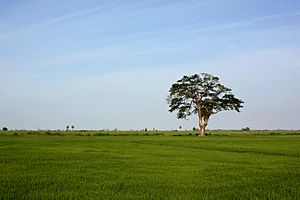Rice production in Sri Lanka facts for kids
Rice production is super important in Sri Lanka. It's one of the main things grown there. Rice is the daily food for almost everyone in Sri Lanka. It also helps over 1.8 million farmers earn a living.
About 30% of all workers in Sri Lanka are involved with growing rice. In 1998, each person ate about 92 kilograms of rice every year. Sri Lanka grew almost all the rice it needed back then. Experts thought the country would need about 3.1 million metric tons of rice by 2005. This meant farmers needed to grow more rice per area of land.
Rice grows in all parts of Sri Lanka. It grows during two main monsoon seasons. These seasons are called Maha and Yala. Maha means "bigger" and Yala means "lesser" in Sinhala. The Maha season is from September to March. The Yala season is from May to August. About 708,000 hectares of land are used for growing rice.
Contents
History of Rice Farming
Growing rice in Sri Lanka has a long history. It goes back to ancient times, between 161 B.C. and 1017 A.D. The weather in Sri Lanka was perfect for growing rice. This made many people choose rice farming as their way of life.
Rice farming became a big part of Sri Lankan society. It was linked to their culture and religious beliefs. The kings of Sri Lanka knew how important rice was. They built huge tanks and lakes to store water. This water was used to irrigate, or water, the large rice fields. Today, machines do much of the work that people and animals used to do. This makes rice farming much more efficient.
Fertilizers and Farming
Chemical fertilizers came to Sri Lanka in the 1950s. Before that, farmers only used natural fertilizers. The government started a program to help farmers buy fertilizers. This was to help them grow more rice. The goal was for Sri Lanka to grow all the rice it needed. It also helped farmers save money.
Most of the chemical fertilizers used in Sri Lanka are brought in from other countries. The fertilizer help program started in 1962. This was around the time of the Green Revolution. This was a time when new farming methods helped grow more food. Three main types of fertilizers were used:
- Urea for nitrogen (N)
- Triple superphosphate (TSP) for phosphorus (P)
- Muriate of potash (MOP) for potassium (K)
The government hoped that more rice production would make rice cheaper for everyone. At first, the help for fertilizers changed based on the type of crop. But this didn't work well. So, in 1975, the government made the help the same for all crops. The amount of help still changed based on the type of fertilizer. This also changed over time because fertilizer prices in the world market often changed.
Organic Farming Efforts
In 2019, the president at the time, Gotabaya Rajapaksa, wanted to stop using artificial pesticides. In April 2021, he said the whole country would switch to organic farming. This means farming without chemical fertilizers or pesticides.
However, many farmers said they did not get training on how to farm organically. The rice harvest in 2021 was not good. This meant Sri Lanka had to spend a lot of money to buy food from other countries. They also had to give money to farmers to help them. This sudden change to organic farming was not successful. The government changed these policies back before the year ended.
Rice Production Numbers
Here are some numbers showing how much rice Sri Lanka produced in 2020:
| Season | Production
(million MT) |
Year |
|---|---|---|
| Maha season | 2020 | |
| Yala season | 2020 | |
| Total | 2020 |


